
Introduction
The Manila Cathedral, also known as the Minor Basilica and Metropolitan Cathedral of the Immaculate Conception, serves as the principal church of the Archdiocese of Manila. Situated within the historic walled city of Intramuros in Manila, Philippines, it honors the Immaculate Conception of the Blessed Virgin Mary, the country’s patron saint.
Originally established as a parish church under the Archdiocese of Mexico in 1571, it later attained diocesan status on February 6, 1579, under the papal bull Illius Fulti Præsido by Pope Gregory XIII. Despite facing damage and destruction multiple times since its inception in 1581, the current and eighth iteration of the cathedral was finalized in 1958.
Having received papal recognition from Pope Gregory XIII and visited by Popes Paul VI, John Paul II, and Francis, the cathedral gained the status of a Minor Basilica by the decree Quod Ipsum Manilensis issued by Pope John Paul II on April 27, 1981.
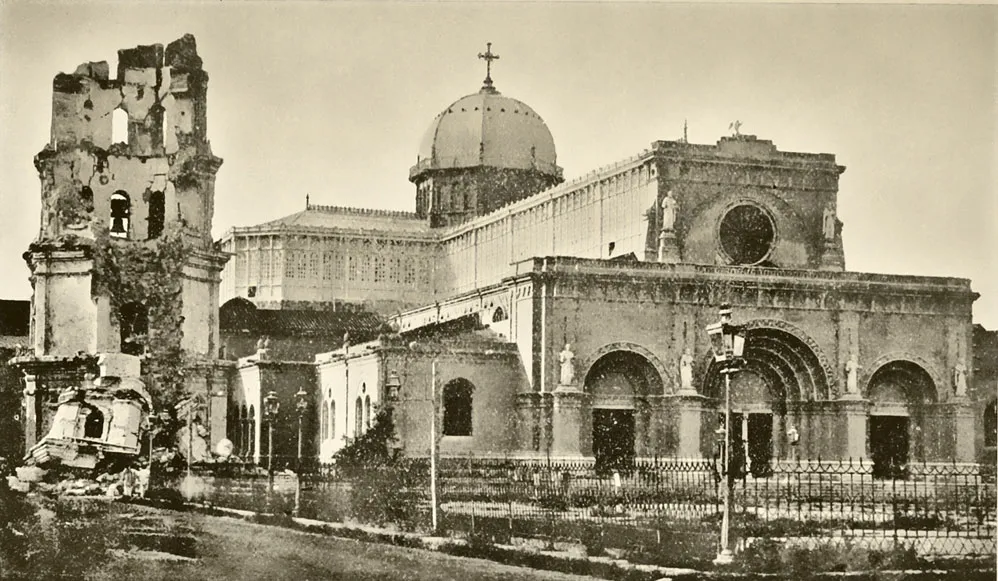
As a Parish Church (1571)
Fray Juan de Vivero, a secular priest who had baptized Rajah Matanda and arrived in Manila Bay in 1566, founded the “Church of Manila” in 1571. Archbishop of Mexico Alonso de Montúfar dispatched De Vivero, chaplain of the galleon San Gerónimo, to establish Christianity as the spiritual and religious authority in the newly colonized Philippines. De Vivero subsequently assumed the roles of vicar-general and the inaugural ecclesiastical judge of Manila.
The church’s location was chosen by Spanish conquistador Miguel López de Legazpi, who dedicated it to Santa Potenciana. Fray Juan de Villanueva served as the church’s first parish priest. Juan de Vivaneta and Nicolas Riccio played integral roles within the parish.
First Cathedral (1581–1583)
In 1579, the church was raised to the status of a cathedral, marking the establishment of the Diocese of Manila. By 1581, Domingo de Salazar, the inaugural bishop of Manila, oversaw the construction of a new cathedral built from nipa, wood, and bamboo. This structure was consecrated on December 21, 1581, formalizing its role as the cathedral. Tragically, the building was destroyed in a fire that broke out during the funeral of Governor-General Gonzalo Ronquillo de Peñalosa at San Agustin Church, causing extensive damage to the city.
Second Cathedral (1592–1600)
The construction of the second cathedral, crafted from stone, commenced in 1592. Featuring a central nave and two collateral naves, the cathedral was nearing completion when Bishop Salazar departed for Spain, where he passed away on December 4, 1594, without returning to assume his role as the first archbishop of Manila.
In 1595, the Holy See bestowed sacred relics upon the cathedral, including those of 155 martyrs, 20 popes, Saint Polycarp, and Saint Potenciana, which were brought to Manila. A separate structure adjacent to the main cathedral was erected to accommodate these relics. Governor-General Juan Niño de Tabora and his wife Doña Magdalena Saldivar y Medoza funded the construction of another auxiliary building to house subsequent relics.
Despite these developments, by 1597, the cathedral complex remained incomplete, lacking essential features such as a chapter hall, baptistry, bell tower, and cloister. Tragically, on December 31, 1600, an earthquake razed the cathedral to the ground.
Third Cathedral (1614–1645)
Archbishop Miguel de Benavides initiated the cathedral’s reconstruction. Following his demise in 1605, his successor Diego Vázquez de Mercado took charge of the project. However, by 1607, the cathedral had deteriorated to such an extent that it was abandoned.
The third cathedral, featuring three naves and seven chapels, was erected in 1614, largely funded by donations from Don Francisco Gomez de Arellano, the fourth dean. The seven chapels were constructed with contributions from the cathedral’s patrons.
On August 1, 1621, an earthquake inflicted severe damage upon the cathedral. Subsequently, between 1641 and 1645, reconstruction efforts were undertaken, only to be thwarted by a series of earthquakes in November and December 1645.
Fourth Cathedral (1671–1751)
Reconstruction of the cathedral commenced upon the arrival of Miguel de Poblete Casasola, the eighth Archbishop of Manila. The cornerstone for the fourth structure was laid on April 20, 1654. Progress was substantial by 1659, with the enclosure of the naves and completion of some halls. In 1662, the main altar, crafted from molave wood, was erected in the cathedral, constructed from quarried stone, lime, and gravel. The completion of the cathedral was marked by a blessing ceremony on June 7, 1662.
In 1750, Florentine friar Juan de Uguccioni augmented the structure by adding a media naranja (“half orange”) dome to the crossing and introducing a transept. However, after enduring several earthquakes and typhoons, the fourth cathedral was ultimately demolished in 1751.
Fifth Cathedral (1760–1852)
Construction of the fifth cathedral commenced following the demolition of its predecessor. Uguccioni’s designs introduced significant alterations, retaining the three-nave layout while reducing the number of chapels. Resembling the Church of the Gesù in Rome, the fifth cathedral was unveiled on December 8, 1760. Since then, the structure remained largely unaltered, save for minor repairs. Notably, repairs were undertaken on the cathedral, particularly its dome, in 1839. Despite enduring the British occupation of Manila, the cathedral sustained damage during repairs. Additionally, it suffered further damage from an earthquake on September 16, 1852.
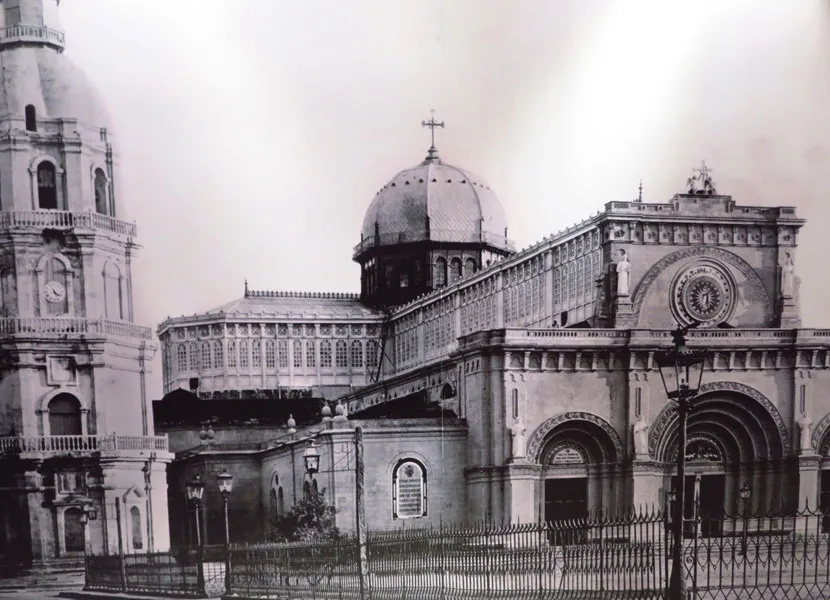
Sixth Cathedral (1858–1863)
Bidding for the cathedral’s reconstruction took place in 1854, and the sixth structure was unveiled on March 31, 1858. Featuring a new Neoclassical façade, this design was retained for the seventh and eighth iterations. The sixth cathedral replaced the Baroque façade of its predecessor, and the truncated cupola was replaced with a circular dome.
However, on June 3, 1863, a powerful earthquake struck, damaging both the sixth cathedral and the Governor General’s palace. Many advocated for the demolition of the cathedral and the clearing of the site. Architect Don Antonio Moraleda initially proposed this course of action in 1866, but the plan was postponed. It was revived in 1868, with architect Vicente Serrano y Salaverri tasked with assessing the ruins. Serrano ultimately recommended the demolition of the cathedral ruins, which occurred in 1870.
Seventh Cathedral (1879–1945)
Construction of the seventh cathedral took place from 1873 to 1879, with its consecration occurring on December 7, 1879. Notably, the cross atop its central dome served as a reference point for the archipelago’s astronomical longitudes. However, in 1880, another earthquake struck, toppling the cathedral’s bell tower, which had previously survived the 1863 earthquake. This event left the cathedral without a tower until 1958.
During the Philippine Revolution of 1896, Archbishop Bernardino Nozaleda y Villa provided shelter to Spanish soldiers within the cathedral. Similarly, during the Philippine–American War, American soldiers repurposed the cathedral into a hospital for their wounded troops.
In 1937, the International Eucharistic Congress took place in the Philippines, with the Manila Cathedral playing a significant role in promoting eucharistic beliefs. To commemorate the event, a cathedral stamp and medal were unveiled, crafted by the official manufacturer of medals for the Congress, sculptor Críspulo Zamora.
However, the cathedral’s fate took a tragic turn during the Battle of Manila in 1945 when Japanese forces destroyed the seventh cathedral as part of a scorched-earth defense strategy.
Eighth Cathedral (1958–present)
Following the Second World War, archbishops Michael J. O’Doherty and Gabriel Reyes initially considered relocating the seat of the Archdiocese of Manila to Mandaluyong. However, this plan was abandoned with the reconstruction of the cathedral under Cardinal Rufino Santos, overseen by Kapampangan architect Fernando Ocampo. The cornerstone of the eighth cathedral was blessed and laid by Cardinal Fernando Quiroga Palacios, the Archbishop of Santiago de Compostela and papal legate of Pope Pius XII, on December 8, 1954. The building was consecrated on December 7, 1958, with the high altar consecrated on December 10 of the same year.
Pope Paul VI conducted an apostolic visit and celebrated Mass in Manila Cathedral on November 27, 1970. Subsequently, Pope John Paul II also celebrated Mass in the cathedral on February 17, 1981, and elevated the cathedral to a minor basilica through his own motu proprio on April 27, 1981. The 50th anniversary of Manila Cathedral’s restoration was commemorated in 2008 with the second Manila Cathedral Pipe Organ Festival from December 2 to 10. The cathedral’s pipe organ, constructed by Dutch organ builder Pels & Zoon in 1958 and consisting of 5,584 pipes, holds the distinction of being the largest church organ in Southeast Asia.
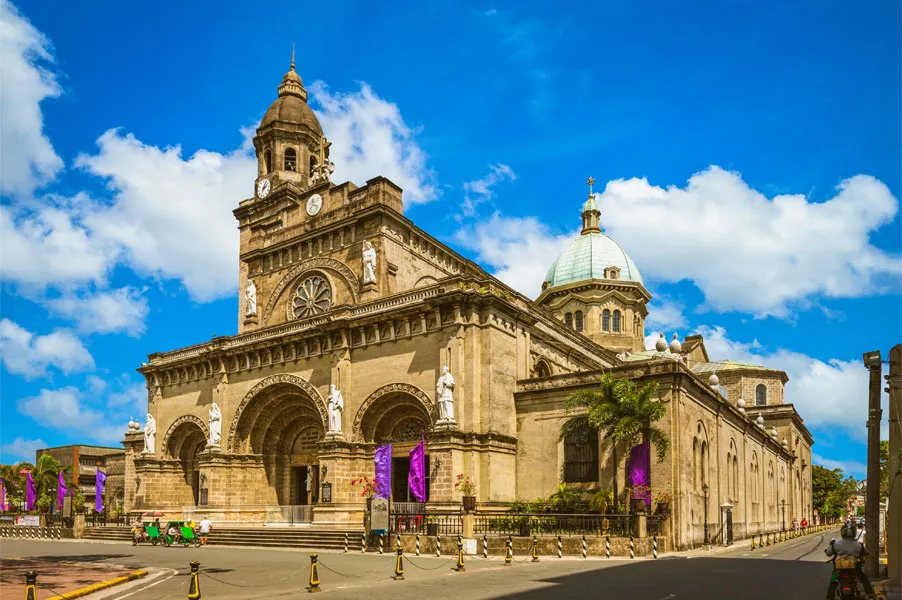
In February 2011, the cathedral’s bells were relocated to the ground level to prevent the bell tower from collapsing, as had occurred with previous towers during past earthquakes. In January 2012, the bells were replaced with new ones cast by blacksmith Friedrich Wilhelm Schilling from Heidelberg, Germany, in 1958. Seven carillon bells weighing 17 metric tons were permanently installed in the ground level of the belfry.
In 2010, cracks were observed in some critical sections of Manila Cathedral, prompting its closure due to failure to meet the standards of the National Structural Code of the Philippines. After Cardinal Luis Antonio Tagle assumed his post as Archbishop of Manila in December 2011, one of his initial decisions was to close the cathedral. Following the 2012 Negros earthquake and structural concerns, the cathedral underwent temporary closure on February 7 for repairs, earthquake retrofitting, and subsidence prevention. Restoration was initially projected to conclude in 2013 but was delayed. Nestor Cerbo announced that renovations would be completed by March 25, 2014. Closed-circuit television (CCTV) cameras, large flat-screen television screens, improved audio-video systems, and enhanced interior and exterior LED lights were installed. Restoration concluded as scheduled, and Manila Cathedral reopened to the public on April 9, 2014, with Archbishop Cardinal Tagle leading a Holy Mass attended by President Benigno Aquino III.
On January 16, 2015, Pope Francis celebrated his first Papal Mass in the country at Manila Cathedral as part of his apostolic visit to the Philippines. The Mass was conducted in Latin, English, and Filipino, and served as a tribute to the bishops, priests, and clergy.
In 2018, the 60th anniversary of Manila Cathedral’s restoration was observed, with Cardinal Tagle rededicating the altar on December 10 in accordance with the rites prescribed by the Second Vatican Council.

The northwest façade of Manila Cathedral, constructed in the Neo-Romanesque architectural style in a Latin cross (cruciform) layout, replicates the façade of the previous cathedral. Adorning this façade are statues of renowned saints sculpted in Roman travertine stone. Numerous artworks within the basilica were created by Italian artists, with statues originally crafted from molave wood in the previous cathedral. Notable sculptures include Rose of Lima by Angelo Fattinanzi, Jacob, Andrew, and Anthony the Abbot by Livia Papini, and Francis Xavier and Polycarp by Alcide Tico. Above the central northwest doors, the tympanum displays the Latin inscription Tibi cordi tuo immaculato concredimus nos ac consecramus (“To thy Immaculate Heart, we entrust and consecrate ourselves”).
In 1981, the papal arms were added to denote the cathedral’s basilica status. Since Pope John Paul II’s apostolic visit to the basilica in 1981, a medallion bearing the papal arms has been positioned beneath the cross of the façade and at the crossing above the high altar. The scarlet galeros of Cardinals Rufino Santos and Jaime Sin are suspended from the dome’s ceiling. Additionally, a replica of the statue Saint Peter Enthroned from St. Peter’s Basilica stands opposite a polychrome, life-sized statue of the Immaculate Conception.
Crafted by Publio Morbiducci, the bronze baptismal font and angel-shaped holy water fonts grace the cathedral. A prominent mosaic of Jude Thaddeus was created by Marcello Mazzoli. In 1964, Filipino artist Galo Ocampo primarily designed and crafted the cathedral’s 134 modern stained glass windows. Santos spearheaded and financed the window set, featuring a program of Marian themes.
The marble floors near the altar’s center aisle bear the coats of arms of four cardinal archbishops of Manila: Rufino Santos, Jaime Sin, Gaudencio Rosales, and Luis Antonio Tagle.
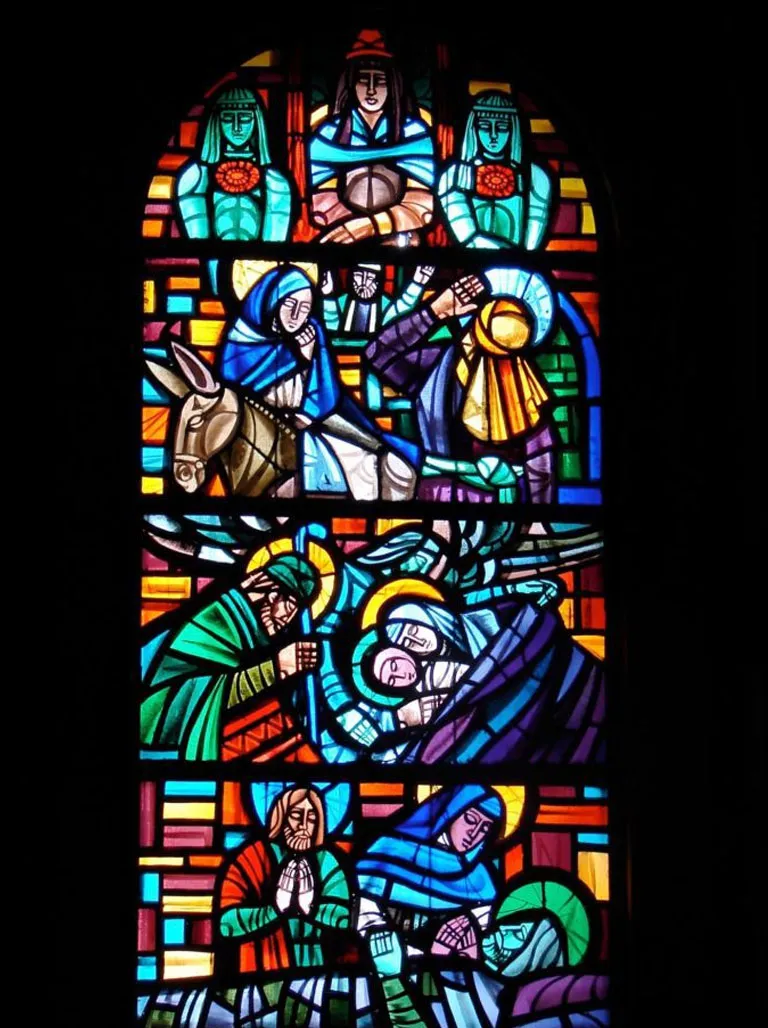
The northwest façade of Manila Cathedral, constructed in the Neo-Romanesque architectural style in a Latin cross (cruciform) layout, replicates the façade of the previous cathedral. Adorning this façade are statues of renowned saints sculpted in Roman travertine stone. Numerous artworks within the basilica were created by Italian artists, with statues originally crafted from molave wood in the previous cathedral. Notable sculptures include Rose of Lima by Angelo Fattinanzi, Jacob, Andrew, and Anthony the Abbot by Livia Papini, and Francis Xavier and Polycarp by Alcide Tico. Above the central northwest doors, the tympanum displays the Latin inscription Tibi cordi tuo immaculato concredimus nos ac consecramus (“To thy Immaculate Heart, we entrust and consecrate ourselves”).
In 1981, the papal arms were added to denote the cathedral’s basilica status. Since Pope John Paul II’s apostolic visit to the basilica in 1981, a medallion bearing the papal arms has been positioned beneath the cross of the façade and at the crossing above the high altar. The scarlet galeros of Cardinals Rufino Santos and Jaime Sin are suspended from the dome’s ceiling. Additionally, a replica of the statue Saint Peter Enthroned from St. Peter’s Basilica stands opposite a polychrome, life-sized statue of the Immaculate Conception.
Crafted by Publio Morbiducci, the bronze baptismal font and angel-shaped holy water fonts grace the cathedral. A prominent mosaic of Jude Thaddeus was created by Marcello Mazzoli. In 1964, Filipino artist Galo Ocampo primarily designed and crafted the cathedral’s 134 modern stained glass windows. Santos spearheaded and financed the window set, featuring a program of Marian themes.
The marble floors near the altar’s center aisle bear the coats of arms of four cardinal archbishops of Manila: Rufino Santos, Jaime Sin, Gaudencio Rosales, and Luis Antonio Tagle.
Cathedra
During the postwar reconstruction in 1958, the cathedra or episcopal throne of the Archbishop of Manila was installed. Crafted from Mexican onyx and marble from Carrara, Italy, it was designed and produced by the Istituto Internazionale d’Arte Liturgica in Rome. Originally, the cathedra showcased the coat of arms of Rufino Santos before his elevation to cardinal status. However, his coat of arms and the Mexican onyx were concealed by a stone until their restoration in 2021.
The restored cathedra now features a carving of the coat of arms of Cardinal Jose Advincula, the current archbishop, atop white Indian marble.
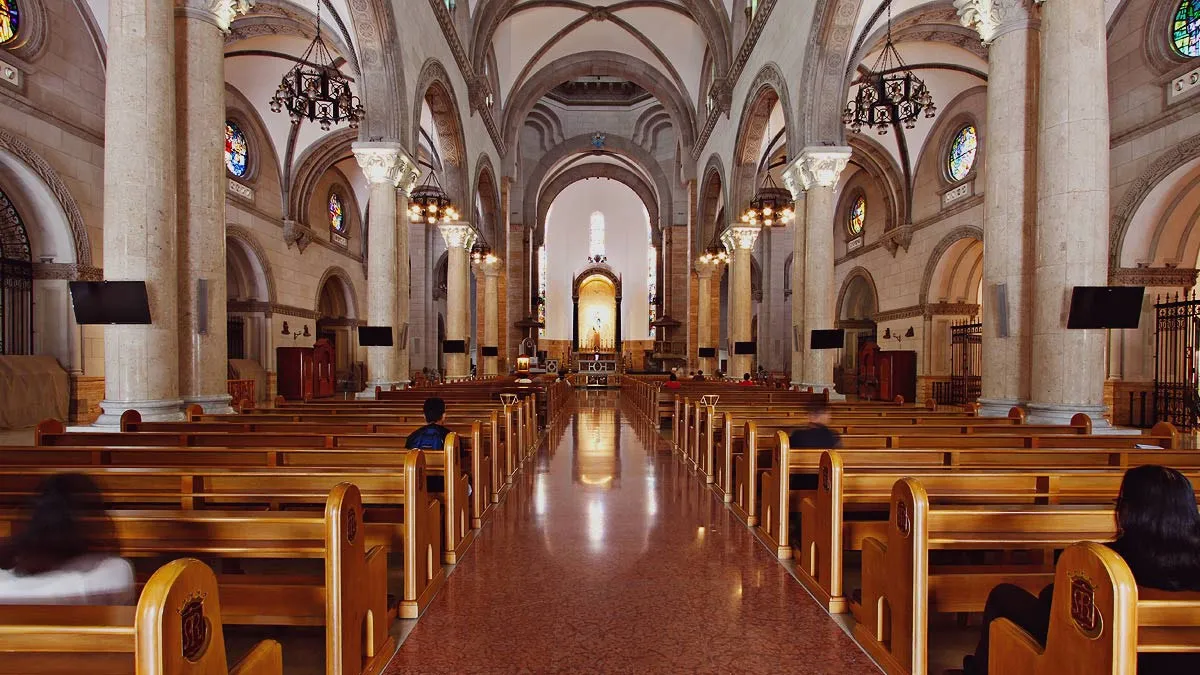
Patroness
Manila Cathedral is devoted to the Blessed Virgin Mary under the title of the Immaculate Conception, revered as the Principal Patroness of the Philippines. Positioned above the high altar is a 9-foot (2.7 m) bronze statue crafted by Italian sculptor Vincenzo Assenza (1915–1981).
Before 1988, the bronze statue was gilded, while its twelve-star halo-aureola remained made of gold. Inscribed on the baldachin above the statue of the Immaculate Conception is the Latin antiphon Tota pulchra es, Maria, et macula originalis non est in Te (“Thou art all-beautiful, Mary, and the original stain [spot] (of sin) is not in thee”).
In 1581, Pope Gregory XIII issued a papal bull consecrating the cathedral building to The Purest and Immaculate Conception of Mary. Miguel López de Legazpi consecrated the City of Manila to Saint Potenciana. Pope Pius XII, on September 12, 1942, reaffirmed this patronage for the Filipino people to La Purísima Inmaculada Concepción through the papal bull Impositi Nobis, while Saint Rose of Lima and Saint Potenciana remained as the secondary patronesses of the Filipino people. The same pope, through “Quidquid ad Dilatandum”, reiterated this declaration of patronage on July 16, 1958, through the chancellor of apostolic briefs Gildo Brugnola, who signed and executed the decree.
The cathedral commemorates its liturgical feast every December 8 as the Feast of the Immaculate Conception.

Burials and Funerals
The cathedral crypt serves as the final resting place for former Archbishops of Manila and other prelates, whose remains rest beneath the church complex and are accessible via a stairway to the right of the altar:
– Michael J. O’Doherty, the last foreign archbishop of Manila
– Gabriel M. Reyes, the first Filipino archbishop of Manila
– Cardinal Rufino J. Santos, the first Filipino cardinal
– Cardinal Jaime L. Sin, a prominent leader of the 1986 People Power Revolution
– Dom Ambrose Agius, bishop and Apostolic Delegate to the Philippines (until 1945; remains later transferred to the Abbey of Our Lady of Montserrat, Mendiola Street, Manila)
Three former Presidents were granted the honor of lying in state under the cathedral dome:
– Emilio Aguinaldo, 1st president of the Philippines (1899-1901) (d.1964)
– Carlos P. Garcia, 8th president of the Philippines (1957–1961) (d. 1971)
– Corazon C. Aquino, 11th president of the Philippines (1986–1992) (d. 2009)
President Aguinaldo was the first president to have a requiem mass said in the restored cathedral, despite his affiliation with Freemasonry and the Aglipayan Church. His remains were interred beneath the dome on February 14, 1964, after Cardinal Rufino Santos officiated the requiem mass. President Garcia was the first layman to lie in state and have his Requiem Mass conducted at the cathedral, while President Aquino was the first woman and the third layperson to receive this honor during her funeral. This departure from tradition marked a significant change, as lying in state beneath the dome was traditionally reserved for Archbishops of Manila.
Annual Feast Day
Feast Date : December 8
The annual feast day of The Manila Cathedral, Philippines, is celebrated on December 8 every year.
Mass Timing
Weekly masses :
Mondays to Fridays – 7:30 AM and 12:10 PM – 7:
Weekend masses :
Saturdays – 7:30 AM ONLY
Sundays – 8:00 AM, 10:00 AM, and 6:00 PM
Church Visiting Hours
- Monday to Friday : 7:00 am–5:00 pm
Contact Info
Cabildo,
132 Beaterio St,
Intramuros,
Manila,
Philippines.
Phone No.
Phone: (632) 8 527-3093
Accomodations
Connectivities
Airway
The nearest major airport to The Manila Cathedral, Philippines is Manila Airport (MNL) Airport, which is 10 km away from the Shrine.
Railway
The nearest Railway to The Manila Cathedral, Philippines is Carriedo Lrt Railway Station, which is 2.1 km away from the Shrine.








